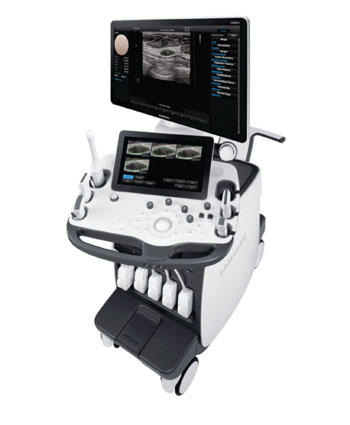Deep Learning Advances Breast Cancer Ultrasound Algorithm
By MedImaging International staff writers
Posted on 16 Jun 2016
A novel computer-aided diagnosis (CADx) solution for ultrasound is based on deep learning from an independently acquired anonymous set of real-life data.Posted on 16 Jun 2016
Developed at Samsung (Seoul, Korea), the innovative S-Detect for Breast CADx algorithm is based on a database of over 10,000 anonymous breast ultrasound images and decades worth of clinical experience from partnering medical institutes and doctors, such as Samsung Medical Center (SMC; Seoul, South Korea). The deep-learning algorithm uses the standardized Breast Imaging-Reporting and Data System (BI-RADS) score for analysis and classification of targeted regions.

Image: The RS80A with Prestige ultrasound device (Photo courtesy of Samsung).
The user simply touches a seed point on the touch screen and the S-Detect automatically sets lesion boundaries, providing multiple images; the BI-RADS score is automatically displayed. The intelligent technology then helps to determine the size and shape of the lesions, gives advice on whether they are benign or malignant, and integrates all that information into a single report that aids in effective diagnosis and reduction of unnecessary biopsies.
The S-Detect algorithm is already incorporated into an upgraded version of the Samsung RS80A with Prestige ultrasound device, offering standardized analysis and classification of suspicious lesions. It includes three modes to set the level of sensitivity and specificity requiered. The RS80A also provides E-Breast elastography technology to calculates the strain ratio for thyroid lesions, and contrast-Enhanced Ultrasound (Low-MI) to process reflected signals from contrast agents, stimulated by particular ultrasound pulses, which produce a unique sonogram with increased contrast.
While final diagnosis and decisions are made by doctors, the S-Detect for Breast can equip them with the knowledge to help them make better decisions faster. Samsung announced that the Samsung Advanced Institute of Technology (SAIT) will conduct further work with partnering medical institutes such as SMC to further improve the S-Detect algorithm and to expand application of the technology to other areas of ultrasound diagnosis, such as the thyroid, liver, and more.
Related Links:
Samsung
Samsung Medical Center














